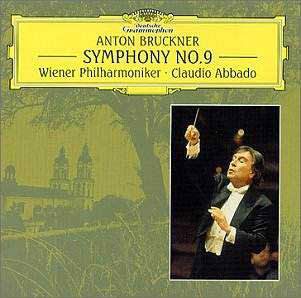Claudio Abaddo has taken his time with his Bruckner
recordings and there is still no sign as to whether he has embarked
on a complete symphony cycle or not. So far DG has released the First,
the Fourth and the Fifth, but a look at the date of this Ninth shows
that it remained in the DG archives for over four years before release.
I wonder why. It canít be because of inferior quality. Opinions and
preferences aside, interpretation and playing are both excellent and
whilst some may find the sound rather closely blended it is still a
rich and refined recording with lots of detail.
First praise must got to the Vienna Philharmonic. Always
special in this composerís music, particularly with a conductor they
like and admire, the brass is powerful and unflagging right the way
through this "live" recording, but they also maintain that
rich, sonorous sound that never tires the ear and can vary tone in the
blinking of an eye. The strings also have the saturation sound these
players specialise in and with Abbadoís stress on the lyrical aspects
of this score maybe at the expense of its architectural that counts
for a lot. Perhaps the woodwinds suffer just a little in the recording
balance but they more than match their colleagues.
As I indicated, Abaddo is, as ever, the lyrical Brucknerian.
This leads him to always make sure that the great outbursts of often
anguished brass in the first movement never sound coarse. This avoidance
of the coarse can diminish somewhat those architectural properties that
are so much a keynote of Brucknerís method. By that I mean that at those
times when Brucknerís geography calls for a sudden mountain range to
be marked very vividly on the musical map Abaddoís instinct is to smooth
over the transition slightly and this is helped by the closer recording.
More air around the instruments would allow the silences to be filled
in by the cathedral reverberation that is always in Brucknerís aural
imagination too. As I say all this accentuates for me the impression
that lyricism rather than architecture is on Abbadoís mind. But no matter,
itís a valid view that Abaddo projects with confidence and conviction
and Iím prepared to go along with it even if I donít find it entirely
convincing myself. In the third movement Abbado therefore shapes the
great themes with a particular warmth and sincerity, more human, less
spiritual, and here he is at his best, his interpretation most appropriate.
Which is not quite what I felt in the first movementís corresponding
sections which need more black mystery, more ghosts in the machine.
For that you want Furtwänglerís 1944 concert recording (Music and
Arts CD730) made in Berlin as that city prepared to burn. However, I
wouldnít want you left with the impression that this is a Bruckner Ninth
without power and heft. There is plenty of that, especially in a powerful
and evil pounding scherzo where the VPO brass shake off their golden
chain mail to replace it with a suit of armour that the Black Prince
himself would have worn with pride.
For many years my own reference version of the Ninth
has mostly been with Karajan and the Berlin Philharmonic on DG Galleria
recorded in 1966 (429 904-2). Karajanís remake from eight years later
is very nearly its equal but I still prefer the more spacious recording
and sense of the numinous of the earlier version, so make sure to order
the number I have given for the 1966 version. Karajan also dares to
make those huge dynamic contrasts that Brucknerís score abounds with
really tell and which Abaddo doesnít seem to want to press too far.
Karajan is also backed by an orchestra whose range of expression in
every part of this score is huge containing powerful, thrilling brass
and string playing that rises to heights of eloquence never equalled
in this work. However, compared with the Vienna Philharmonic for Abbado
you do have the impression that the Berliners of 1966 have been given
their heads to an extent that the slightly more reined-back Viennese
are not and there is enough air in the acoustic for them to really stand
out. Listen to the black trombones, the ringing trumpets, the achingly
beautiful cellos and, above all, Karajanís sense of the dramatic matched
with his flair for heavenly calm. Apart from Karajan I have also always
admired Bruno Walterís nobler and softer-grained reading on Sony (SMK64483)
which is perhaps a better example of the kind of performance
Abaddo seems to be aiming for.
This is an interesting and rewarding Bruckner Ninth.
Not one to replace other top recommendations, but certainly one to take
down for a distinctive view.
Tony Duggan


![]() See
what else is on offer
See
what else is on offer 